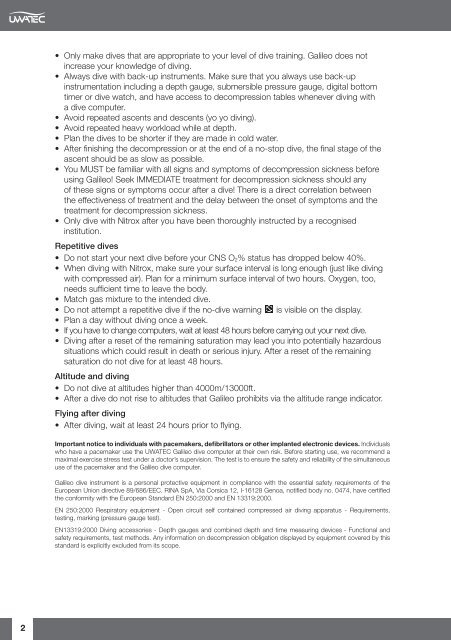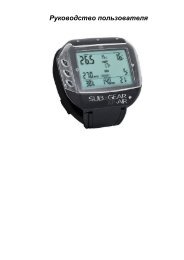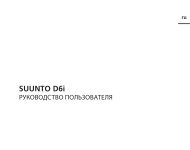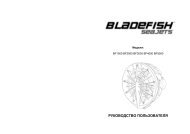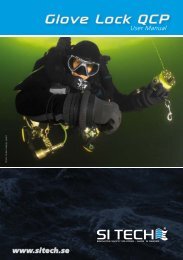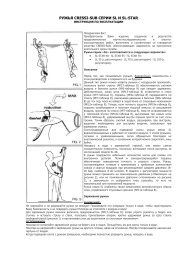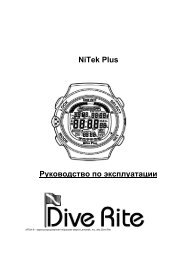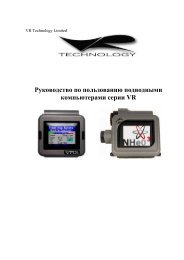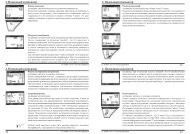Galileo SOL Manual - Scubapro
Galileo SOL Manual - Scubapro
Galileo SOL Manual - Scubapro
Create successful ePaper yourself
Turn your PDF publications into a flip-book with our unique Google optimized e-Paper software.
• Only make dives that are appropriate to your level of dive training. <strong>Galileo</strong> does not<br />
increase your knowledge of diving.<br />
• Always dive with back-up instruments. Make sure that you always use back-up<br />
instrumentation including a depth gauge, submersible pressure gauge, digital bottom<br />
timer or dive watch, and have access to decompression tables whenever diving with<br />
a dive computer.<br />
• Avoid repeated ascents and descents (yo yo diving).<br />
• Avoid repeated heavy workload while at depth.<br />
• Plan the dives to be shorter if they are made in cold water.<br />
• After fi nishing the decompression or at the end of a no-stop dive, the fi nal stage of the<br />
ascent should be as slow as possible.<br />
• You MUST be familiar with all signs and symptoms of decompression sickness before<br />
using <strong>Galileo</strong>! Seek IMMEDIATE treatment for decompression sickness should any<br />
of these signs or symptoms occur after a dive! There is a direct correlation between<br />
the effectiveness of treatment and the delay between the onset of symptoms and the<br />
treatment for decompression sickness.<br />
• Only dive with Nitrox after you have been thoroughly instructed by a recognised<br />
institution.<br />
Repetitive dives<br />
• Do not start your next dive before your CNS O 2% status has dropped below 40%.<br />
• When diving with Nitrox, make sure your surface interval is long enough (just like diving<br />
with compressed air). Plan for a minimum surface interval of two hours. Oxygen, too,<br />
needs suffi cient time to leave the body.<br />
• Match gas mixture to the intended dive.<br />
• Do not attempt a repetitive dive if the no-dive warning is visible on the display.<br />
• Plan a day without diving once a week.<br />
• If you have to change computers, wait at least 48 hours before carrying out your next dive.<br />
• Diving after a reset of the remaining saturation may lead you into potentially hazardous<br />
situations which could result in death or serious injury. After a reset of the remaining<br />
saturation do not dive for at least 48 hours.<br />
Altitude and diving<br />
• Do not dive at altitudes higher than 4000m/13000ft.<br />
• After a dive do not rise to altitudes that <strong>Galileo</strong> prohibits via the altitude range indicator.<br />
Flying after diving<br />
• After diving, wait at least 24 hours prior to fl ying.<br />
Important notice to individuals with pacemakers, defibrillators or other implanted electronic devices. Individuals<br />
who have a pacemaker use the UWATEC <strong>Galileo</strong> dive computer at their own risk. Before starting use, we recommend a<br />
maximal exercise stress test under a doctor’s supervision. The test is to ensure the safety and reliability of the simultaneous<br />
use of the pacemaker and the <strong>Galileo</strong> dive computer.<br />
<strong>Galileo</strong> dive instrument is a personal protective equipment in compliance with the essential safety requirements of the<br />
European Union directive 89/686/EEC. RINA SpA, Via Corsica 12, I-16128 Genoa, notifi ed body no. 0474, have certifi ed<br />
the conformity with the European Standard EN 250:2000 and EN 13319:2000.<br />
EN 250:2000 Respiratory equipment - Open circuit self contained compressed air diving apparatus - Requirements,<br />
testing, marking (pressure gauge test).<br />
EN13319:2000 Diving accessories - Depth gauges and combined depth and time measuring devices - Functional and<br />
safety requirements, test methods. Any information on decompression obligation displayed by equipment covered by this<br />
standard is explicitly excluded from its scope.<br />
2


